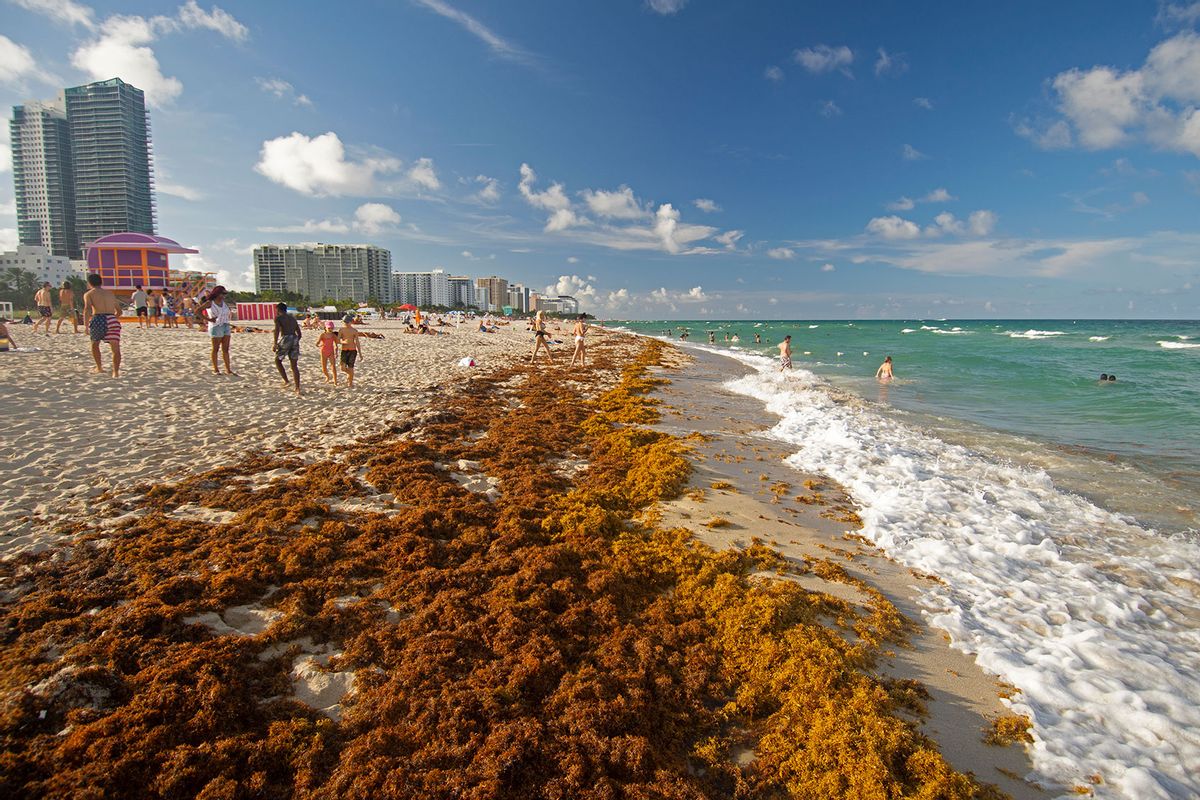In the past week, numerous news outlets warned of a massive "seaweed blob" destined to take over Florida's east coast. "Massive seaweed bloom starts washing ashore on Florida beaches," the New York Post reported. "A seaweed blob twice the width of the US is heading toward Florida," CNN forewarned.
While the headlines make it sound as if an algal Loch Ness monster is about to destroy Florida beaches — during prime spring break season, too — one oceanographer tells Salon this claim is nothing short of sensational.
Dr. Yuyuan Xie uses satellites to study Sargassum, a genus of large brown algae that floats around in island-like masses. "There is no 'seaweed blob,'" Xie, who works in the Optical Oceanography Laboratory at the University of South Florida, told Salon. "But there is a 5,000-mile Great Atlantic Sargassum Belt," which, Xie says, is comprised of less than one-tenth of one percent seaweed.
In other words, Sargassum only makes up 0.1 percent of the belt; the other 99.9 percent of the belt is "Sargassum free" — just normal ocean water.
Xie noted that this belt is not "moving towards Florida," like some kind of ominous monster, but that only a "tiny portion of seaweed within the belt" has, and will, reach the east coast of Florida and the Florida Keys.
Technically, Sargassum seaweed belts are not new phenomena. According to a paper published in the peer-reviewed journal Science, floating belts of Sargassum seaweed were first reported in the 15th century by Christopher Columbus. Over the last few centuries, scientists reported that these "mats" have been "limited" and "discontinuous." But in 2011, they started to increase in prevalence and density again, resulting in an 8,850-kilometer-long bloom extending from West Africa to the Caribbean Sea and Gulf of Mexico. "This represents the world's largest macroalgal bloom," the researchers reported. "Such recurrent blooms may become the new normal."
Want more health and science stories in your inbox? Subscribe to Salon's weekly newsletter The Vulgar Scientist.
Xie and his colleagues track Sargassum seaweed's annual cycle, and use NASA satellites to collect data on its size. Compared to a decade ago, Xie called the phenomenon "unusual" because "such a belt did not exist" back then. But in line with Sargassum behavior in the last five years, this belt is typical as the Sargassum enters another annual cycle.
It's typical for these Sargassum belts to stretch for miles across the ocean's surface, and they can serve as a floating home for animals such as sea turtles, marine birds, shrimps and crabs.
According to the National Oceanic and Atmospheric Administration (NOAA), Sargassum is unlike typical seaweeds that are usually anchored to the bottom of the ocean by root-like "holdfasts." In contrast, Sargassum never anchors to the ocean floor, and thus floats on the surface. It's typical for these Sargassum belts to stretch for miles across the ocean's surface, and they can serve as a floating home for animals such as sea turtles, marine birds, shrimps and crabs. There is even a type of frogfish known as "sargassum fish" who live solely in this habitat.
Xie told Salon Sargassum is plentiful in a region of the North Atlantic Ocean called the Sargasso Sea, which is bounded by four different currents. Since there are no land boundaries around this region, it is often characterized by its brown Sargassum seaweed. As to why a floating mat of it has become the "new normal" in the Tropical Atlantic region, there are a couple of possibilities.
"In 2010, there were stronger-than usual winds and currents; it is speculated that these could bring Sargassum to the Tropical Atlantic, where all conditions (light, nutrients, temperature) are favorable for growth in subsequent years," Xie said. "But the factors impacting its growth vary from year to year, and this is why we see more in some years than in other years."
In other words, expect more headlines claiming there are "big blobs of seaweed" coming to Florida.



Shares